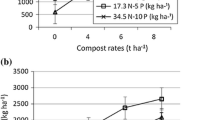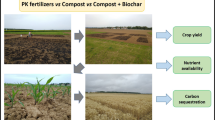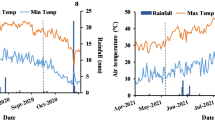Abstract
In Niger, farmers rely largely on organic resources such as manure and compost to address soil fertility problems and improve crop production. Ironically, they do not improve the fertilizer value of these organic resources or take into account their decomposition and nutrient release patterns before the application. This study aimed to assess the decomposition and nutrient release patterns of composted manure under field conditions and its implication on millet and cowpea grain yield. Litterbags arranged in randomized complete block design (RCBD) with three replications were used to assess decomposition and nutrient release of the compost. For the effect of composted manure and mineral fertilizer on millet and cowpea grain yield, two types of soil amendments were used; three levels of compost and four levels of mineral fertilizer. A 3 × 4 factorial experiment arranged in RCBD with three replications was used. After 84 days of decomposition, 40.3 and 56.5 % of compost mass losses were recorded respectively in 2013 and 2014. In 2013, 31, 74 and 97 % of N, P and K, respectively were released at 63 days of decomposition. Furthermore, in 2014, N, P and K release values of 58, 60 and 99 % were obtained at 84 days of decomposition. Combined application of 2500 kg ha−1 compost + 175/100 kg ha−1 NPK significantly (P < 0.001) recorded the highest millet yields of 1762 and 866 kg ha−1 while the highest cowpea yields of 360.5 and 389 kg ha−1 resulted from the application of 2500/5000 kg ha−1 compost + 75 kg ha−1 DAP. These findings suggest that, compost resulting from cattle manure plus cowpea haulm can be used by smallholder farmers to address soil fertility decline, improve nutrient availability and raise pearl millet and cowpea grain yield under strip cropping system.




Similar content being viewed by others
References
Amba A, Agbo E, Garba A (2013) Effect of nitrogen and phosphorus fertilizers on nodulation of some selected grain legumes at Bauchi, Northern Guinea Savanna of Nigeria. Int J Biosci 3(10):1–7
Anderson JM, Ingram JS (1998) Tropical soil biology and fertility: a hand book of methods of analysis. CAB International, pp 39
Augustin C, Rahman S (2010) Composting animal manures: a guide to the process and management of animal manure compost. Extension service North Dakota University
Badiane A, Faye A, Yamoah CF, Dick R (2001) Use of compost and mineral fertilizers for millet production by farmers in the semiarid region of Senegal. Biol Agric Hortic 19(3):219–230
Bationo A, Kihara J, Vanlauwe B, Waswa B, Kimetu J (2007) Soil organic carbon dynamics, functions and management in West African agro-ecosystems. Agric Syst 94(1):13–25
Bray RH, Kurtz L (1945) Determination of total, organic, and available forms of phosphorus in soils. Soil Sci 59(1):39–46
Buerkert A, Moser M, Kumar AK, FuÈrst P, Becker K (2001) Variation in grain quality of pearl millet from Sahelian West Africa. Field Crops Res 69(1):1–11
Chukwuka K (2009) Soil fertility restoration techniques in sub-Saharan Africa using organic resources. Afr J Agric Res 4(3):144–150
Esse PC, Buerkert A, Hiernaux P, Assa A (2001) Decomposition of and nutrient release from ruminant manure on acid sandy soils in the Sahelian zone of Niger, West Africa. Agric Ecosyst Environ 83:55–63
Ewusi–Mensah N (2009) Optimizing manure quality for increased food production on small holder farms in the upper east region of Ghana. Ph.D. Thesis, Faculty of Agriculture, Kwame Nkurma University of Science and Technology, Kumasi, Ghana, pp 205
Fatondji D, Martius C, Bielders CL, Vlek PLG, Bationo A, Gerard B (2009) Decomposition of organic amendment and nutrient release under the zai technique in the Sahel. Nutr Cycl Agroecosyst 85:225–239
Garba M (2014) On-farm assessment of physico-chemical properties of an arenosol under application of mineral fertilizers and their impact on the yield of millet in the sahelian zone of niger Ph.D thesis, KNUST-Ghana. p 149
Gnankambary Z, Bayala J, Malmer A, Nyberg G, Hien V (2008) Decomposition and nutrient release from mixed plant litters of contrasting quality in an agroforestry parkland in the south-Sudanese zone of West Africa. Nutr Cycl Agroecosyst 82(1):1–13
Hagedorn F, Steiner K, Sekayange L, Zech W (1997) Effect of rainfall pattern on nitrogen mineralization and leaching in a green manure experiment in South Rwanda. Plant Soil 195(2):365–375
Haile W, Boke S, Box P (2009) Mitigation of soil acidity and fertility decline challenges for sustainable livelihood improvement: research findings from souther region of Ethiopia and its policy implications. Awassa Agricultural Research Institute
Harris F (2002) Management of manure in farming systems in semi-arid west africa. Exp Agric 38:131–148
Houba VJ, Novozamsky I, Van der Lee J (1995) Soil analysis procedures: other procedures. Department of Soil Science and Plant Nutrition, Wageningen Agricultural University
Issaka M (2001) Évolutions à long terme de la fertilité de sol dans la région de Maradi. Drylands Research. Working Paper No. 30, Drylands Research, Crewkerne, United Kingdom
Jahn R, Blume H, Asio V, Spaargaren O, Schad P (2006) Guidelines for soil description, 4th edn. FAO, Rome
Kapkiyai J, Karanja N, Woomer P, Qureshi J (1998) Soil organic carbon fractions in a long-term experiment and the potential for their use as a diagnostic assay in highland farming systems of Central Kenya Highlands
Manu A, Bationo A, Geiger SC (1991) Fertility status of selected millet producing soils of west Africa with emphasis on phosphorus. Soil Sci 152(5):315–320
Marshall T, Holmes J (1988) Soil physics, 2nd edn. Cambridge University press, pp 57–58
Mason SC, Maman N, Palé S (2014) Pearl millet production practices in semi-arid West Africa: review. Cambridge University Press, Cambridge, pp 1–21
Metson A (1961) Methods of chemical analysis for soil survey samples. Department of Scientific and Industrial Research. New Zealand. Soil Bureau bulletin 12
Moore J, Klose S, Tabatabai M (2000) Soil microbial biomass carbon and nitrogen as affected by cropping systems. Biol Fertil Soils 31(3–4):200–210
Nelson D, Sommers L (1973) Determination of total nitrogen in plant material. Agron J 65(1):109–112
Olson JS (1963) Energy storage and the balance of producers and decomposers in ecological systems. Ecology 44(2):322–331
Onduru D, Snijders P, Muchena F, Wouters B, De Jager A, Gachimbi L, Gachini G (2008) Manure and soil fertility management in sub-humid and semi-arid farming systems of sub-saharan Africa: experiences from Kenya. Int J Agric Res 3(3):166–187
Partey ST, Quashie-Sam SJ, Thevathasan NV, Gordon AM (2011) Decomposition and nutrient release patterns of the leaf biomass of the wild sunflower (Tithonia diversifolia): a comparative study with four leguminous agroforestry species. Agrofor Syst 81(2):123–134
Saidou AK, Omae H, Tobita S (2010) Combination effect of crop design and crop densities in the system of millet/cowpea rotation in the sahel, West Africa. American-Eurasian J Agric Environ Sci 7(6):644–647
Saidou AK, Bassirou A, Mamadou A, Adakal H (2014) Effect of compost amended with urea on crops yields in a strip cropping system millet/cowpea on sandy soil poor in P. Res J Agric Environ Sci 1(2):23–28
Soil Laboratory Staff (1984) Analytical methods of the service Laboratory for soil, plant and water analysis. Part I: Methods for soil analysis. Royal Tropical Institute, Amsterdam
Soon YK, Clayton GW, Rice WA (2001) Tillage and previous crop effects on dynamics of nitrogen in a wheat–soil system. Agron J 93(4):842–849
Stoffella PJ, Li Y, Roe NE, Ozores-Hampton M, Graetz DA (1997) Utilization of composted organic wastes in vegetable production systems. Asian and Pacific Concil (ASPAC) Food and Fertilizer Technology Center
Vanlauwe B, Palm C, Murwira H, Merckx R (2002) Organic resource management in sub-Saharan Africa: validation of a residue quality-driven decision support system. Agronomie 22(7–8):839–846
Yamoah CF, Bationo A, Shapiro B, Koala S (2002) Trend and stability analyses of millet yields treated with fertilizer and crop residues in the Sahel. Field Crops Res 75(1):53–62
Acknowledgments
We gratefully acknowledge Alliance for a Green Revolution in Africa (AGRA) who provided the full financial support for this research and KNUST, for the guidance and supervision during the study.
Author information
Authors and Affiliations
Corresponding author
Rights and permissions
About this article
Cite this article
Abdou, G., Ewusi-Mensah, N., Nouri, M. et al. Nutrient release patterns of compost and its implication on crop yield under Sahelian conditions of Niger. Nutr Cycl Agroecosyst 105, 117–128 (2016). https://doi.org/10.1007/s10705-016-9779-9
Received:
Accepted:
Published:
Issue Date:
DOI: https://doi.org/10.1007/s10705-016-9779-9




